


In recent years, Hindi fiction content on streaming platforms has witnessed a steady rise in both volume and thematic diversity. However, with the growing success of shows set in rural backdrops, most notably the four-part franchise Panchayat, an important question emerges: Does the setting of a Hindi web-series influence its audience engagement and performance? And if so, how?
To explore this, all Hindi original fiction series released between January 2024 and June 2025 on major pay or freemium platforms (JioHotstar, Amazon Prime Video, Netflix, SonyLIV, and ZEE5) were categorized based on their primary setting. Series set in international or multi-location backdrops, as well as animated titles, were excluded. For series with multiple seasons released during this period, only the latest season was considered. These filters resulted in a list of 74 Hindi web-series.
Metro vs. Non-Metro breakup
Of the 74 series, 55% (41 titles) are set in one of India’s six metro cities, while the remaining 45% (33 titles) are set outside metros. Within the non-metro group, only three shows (Panchayat, Gram Chikitsalay and Dupahiya) are set in rural India, with the rest based in mini-metros or small town settings.

Interestingly, the metro-based titles are heavily concentrated in just two cities: Mumbai and Delhi NCR account for 36 of the 41 metro-based series. In effect, 49% of all Hindi fiction series launched in the period of analysis are set in just these two cities!
Are Mumbai and Delhi NCR over-represented in Hindi fiction content on OTT? To answer this question, we must examine how these series perform compared to those set in non-metro locations.
For this analysis, Ormax Power Rating (OPR) of these two categories of shows was analyzed. OPR, a single point score of a 0-100 scale, is the key performance metric of audience likeability and advocacy, which is used extensively in our content testing work. A higher OPR indicates stronger word-of-mouth, with scores of 60 or above considered indicative of strong engagement and positive advocacy.
The average OPR for metro-based series is 53, compared to 55 for non-metro series. While this two-point gap is not statistically significant, it clearly establishes that metro settings do not provide any inherent advantage in terms of audience engagement.
Of the 74 Hindi web-series analyzed, 15 achieved an OPR of 60 or higher. Only six of these are set in metro citiess, while the remaining nine are based in mini-metros, small towns or rural India. In effect, while non-metro titles account for only 45% of the overall supply, they contribute 60% of the high-engagement shows. Notably, all three rural-based shows mentioned earlier surpassed the 60-OPR threshold - a 100% success rate!

These data points suggest that non-metro, small town, or rural settings are more likely to foster deeper audience resonance compared to metro-based stories. Let’s understand some key factors that influence this mismatch between supply and audience engagement.
Setting-dependent storytelling
One reason non-metro shows often perform better is that their settings are integral to the storytelling. These narratives are rooted in local culture, dialect, and social dynamics, making the setting a vital part of the viewing experience. Many metro-based shows, by contrast, offer only superficial representations of their cities. In comparison, non-metro stories like Panchayat, Mirzapur, Gullak, Kota Factory, and Gram Chikitsalay derive depth and authenticity from their environments, making them both distinctive and relatable.

When half of all Hindi web-series set in just two cities, any alternative setting naturally stands out as distinctive, simply because audiences are less likely to have encountered it before. By avoiding stereotypes and caricatures, and instead presenting culturally-grounded narratives that reflect the lived realities of rural India, these shows demonstrate genuine respect for their settings, resulting in stronger emotional resonance with audiences.
Alienating elite urban milieus
Some underperforming metro-set shows portray elite urban lifestyles that feel distant and inaccessible to large sections of the audience. In many cases, these settings fail to offer even the aspirational or voyeuristic appeal of affluence, diminishing their entertainment value. This sense of alienation is particularly acute among non-metro viewers, who are likely to fuel the next wave of OTT growth in India.
In contrast, 60+ OPR shows like Taaza Khabar, Khauf, and Khakee: The Bengal Chapter, though metro-based, avoid this disconnect by featuring grounded narratives and characters with relatable struggles.
A comforting escapism
The form of escapism offered by metro and non-metro shows often differs significantly. Urban escapism tends to center on glamour, cynicism, and complex interpersonal dynamics. In contrast, non-metro shows offer a more optimistic, emotionally-accessible form of escape. Conflicts are rooted in everyday realities - jobs, family expectations, local politics - rather than existential angst or high-stakes crime. This makes non-metro stories feel comforting and familiar, enhancing their emotional connect.
In conclusion
In conclusion, the dominance of metro settings in Hindi web series appears to reflect a creator-driven bias rather than audience preference. As platforms expand their content offerings, moving beyond overused urban templates and embracing diverse geographies will offer viewers the authenticity and novelty they seek, especially in an increasingly cluttered content landscape.

From CTV to Micro Dramas: India's fascinating OTT spectrum
The simultaneous rise of Connected TV and Micro Drama audiences in India over the last year highlights how the Indian OTT market is expanding at both the premium and the mass ends simultaneously

Product update: Content testing for the horror genre
Based on our accumulated audience insights, we are introducing genre-specific drivers for horror films and series in our content testing tools, Ormax Moviescope and Ormax Stream Test

Streaming has a new bias: The male lead
An analysis of 338 Hindi fiction originals since 2022 highlights a growing imbalance in the Indian streaming ecosystem, with male-led stories steadily taking over
Subscribe to stay updated with our latest insights
We use cookies to improve your experience on this site. To find out more, read our Privacy Policy